Fashion is a social agreement, the result of a consensus of a large group of people.
Stella Blum (1916 - 1985)
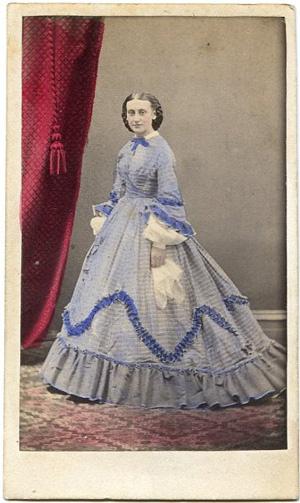
Da un punto di vista economico già prima della Guerra di Secessione, in America le differenze tra nord e sud erano notevoli: il nord, più popolato, prospero, urbanizzato ed industrializzato, il sud che ancora si reggeva su di una economia agricola governata dal 'Re cotone', perciò oltre quella della schiavitù vi era una motivazione anche di tipo economico che condusse a tale disastroso conflitto che vide il sud divenire sempre più povero ( gli stati confederati, investendo quanto più potevano nell'industria bellica, bloccarono le loro esportazioni di cotone sperando nell'aiuto degli stati europei quali Francia e Gran Bretagna delle cui industrie tessili erano i principali fornitori, ma ciò non accadendo si trovarono a perdere i loro mercati oltreoceano, che preferirono l'India ed il Brasile, e a vivere in una sorta di autarchia: Il prezzo non solo di un articolo di lusso, ma anche di uno di manifattura era proibitivo. Nel 1864, quando la paga mensile di un soldato era di 18 $ uno spazzolino da denti costava 8 $ e per acquistare un coltellino tascabile o una libbra di caffè ci voleva un intero stipendio, 18 $. ( Inutile dire che l'economia alla fine del conflitto era compromessa ed era tornato in voga una sorta di baratto.) il nord cresceva demograficamente a vista d'occhio perché i movimenti migratori provenienti dall'Europa si dirigevano verso gli stati settentrionali, e la sua economia, di conseguenza, ne trovò giovamento, anche se, ovviamente, era quello bellico il settore economico privilegiato.
Facendo un discorso generale, le donne che erano rimaste a casa con i loro vecchi, i loro figlioli e gli uomini di salute cagionevole che l'esercito aveva rifiutato, dovettero ingegnarsi per procurasi ogni cosa, dalla più banale ed indispensabile a quella meno necessaria, tanto a sud quanto a nord.
E certo i capi di abbigliamento, pur facendo parte dei beni di prima necessità, venivano dopo l'approvvigionamento delle cibarie, che al sud continuavano a venir date in gran parte dalla terra, al nord dovevano essere obbligatoriamente acquistate.
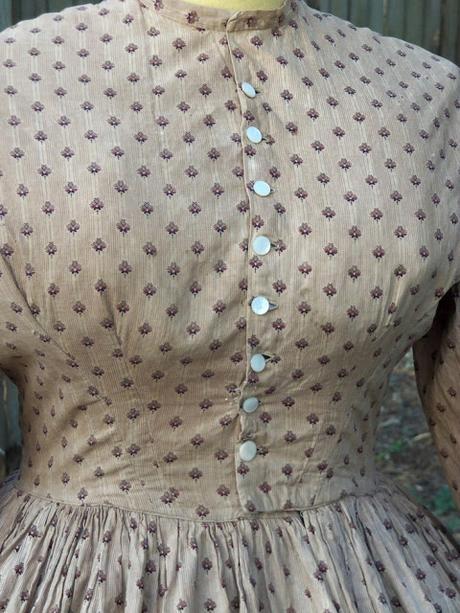 Avete in mente quei dolcissimi abiti con fantasie a piccoli fiori, quadri, pois che fanno innamorare ?
Avete in mente quei dolcissimi abiti con fantasie a piccoli fiori, quadri, pois che fanno innamorare ?Ebbene, durante la Guerra di Secessione le stoffe erano quasi introvabili e le poche che vi erano in commercio avevano prezzi del tutto inaccessibili, per cui le donne si ingegnarono utilizzando ciò che avevano in casa: tovaglie, lenzuola, scampoli di tessuto da mettere insieme con l'aiuto della fantasia e della creatività, giocando con l'ausilio di inserti e di dettagli, talvolta molto elaborati ...
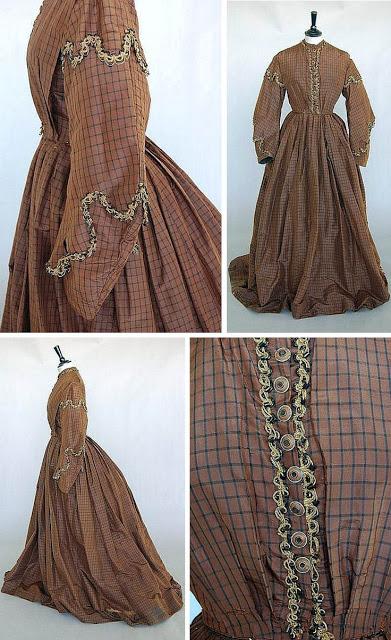
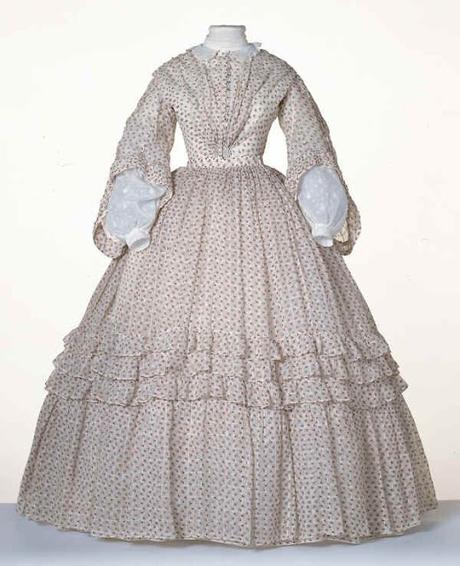
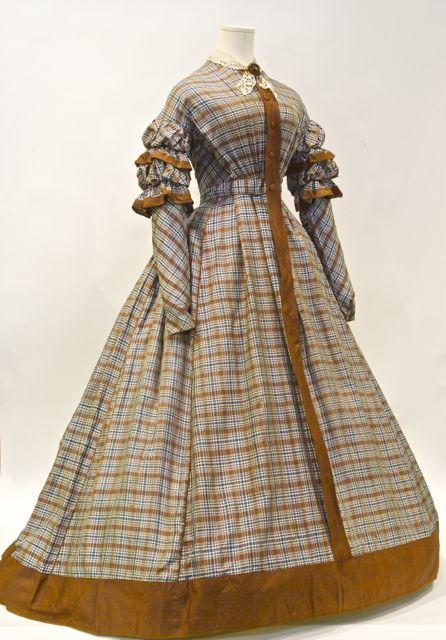
Ed ecco che fanno la loro comparsa e diventano 'di moda' abiti dai colori sgargianti, vivaci, a righe e a quadri - i così detti PLAID DRESSES - di una dolcezza irripetibile che rendono unico questo periodo della storia della moda in ogni donna sembra trasformarsi in una bambola per come si abbiglia
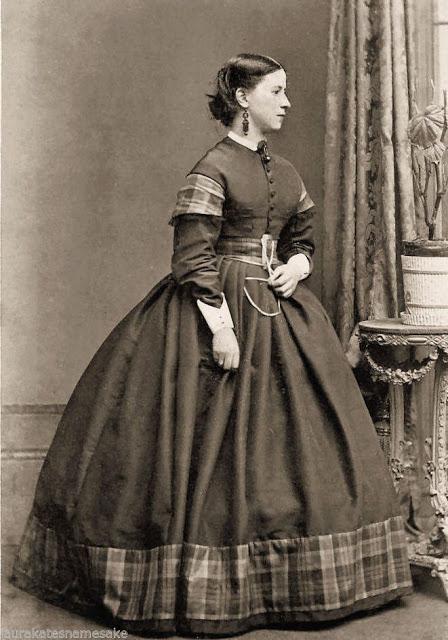
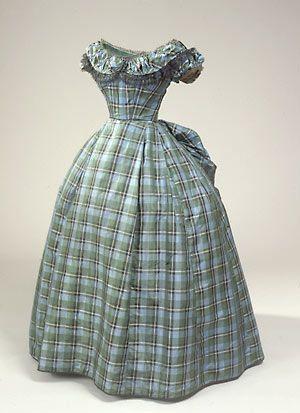
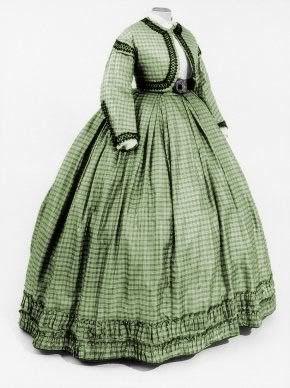
anche se tutto ciò trova giustificazione nell'economia del triste periodo storico di cui stiamo parlando.
Ricorderete sicuramente tutti la scena del film Via col Vento in cui Rossella O'Hara, quasi di smania, tira giù dal bastone le tende di velluto verde brillante che ornavano l'ampia finestra del salone della meravigliosa dimora della tenuta di Tara, chiedendo a Mamy di fargliene un vestito per andare a trovare il suo Rhett:

le tende, sì, proprio gli imponenti tendoni che erano il dettaglio che più rendeva affascinanti i saloni delle dimore delle famiglie più benestanti, dei proprietari terrieri al sud o degli abitanti dei primi nuclei urbani al nord non servivano più, le imposte erano spesso tenute chiuse in modo da dare l'impressione che la dimora fosse stata abbandonata ( senza uomini in casa che potessero gestire armi e difendere la famiglia le donne cercavano di difendersi come potevano ) ed anche questi metri e metri di stoffa pregiata, insieme con le passamanerie che li impreziosivano,servirono per confezionare gli abiti più sofisticati, quelli da passeggio o da cerimonia.
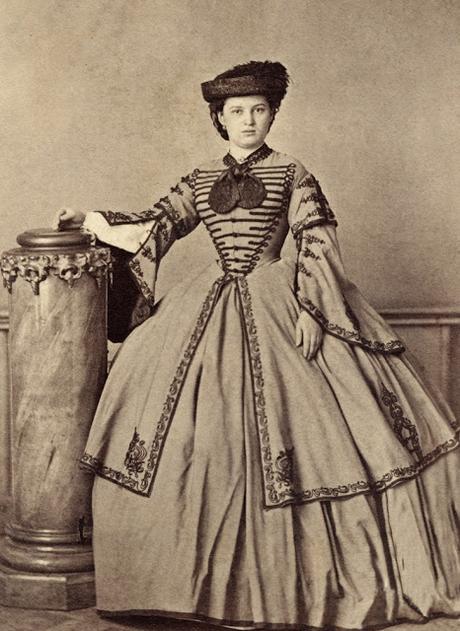
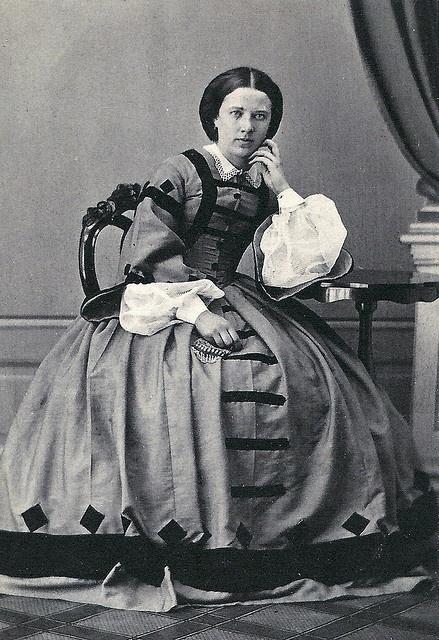
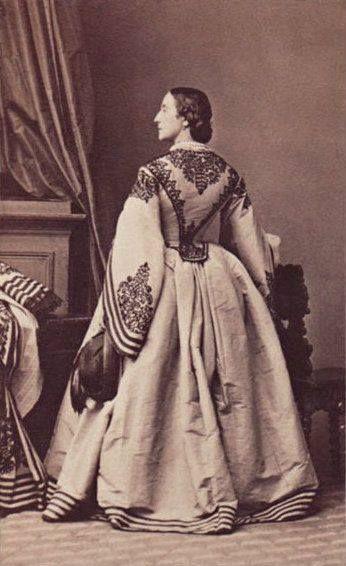 L'ampiezza dei tagli delle stoffe era quella che era e così pure la loro pesantezza perciò talvolta per ovviare a tali limiti vediamo abiti con sovrapposizioni, a più livelli, e maniche senza polsi che non coprono la totalità della lunghezza del braccio: divengono infatti di moda in questo periodo anche le PAGODA SLEEVES, le maniche a pagoda, ovvero maniche che finiscono al culmine della loro ampiezza sotto cui venivano riportate, per non lasciare passare il freddo, sotto-maniche di tessuto bianco, magari abbondanti al polso, spesso ricamate, cucite fino alla spalla o agganciate al corsetto per poter essere utilizzate con abiti differenti.
L'ampiezza dei tagli delle stoffe era quella che era e così pure la loro pesantezza perciò talvolta per ovviare a tali limiti vediamo abiti con sovrapposizioni, a più livelli, e maniche senza polsi che non coprono la totalità della lunghezza del braccio: divengono infatti di moda in questo periodo anche le PAGODA SLEEVES, le maniche a pagoda, ovvero maniche che finiscono al culmine della loro ampiezza sotto cui venivano riportate, per non lasciare passare il freddo, sotto-maniche di tessuto bianco, magari abbondanti al polso, spesso ricamate, cucite fino alla spalla o agganciate al corsetto per poter essere utilizzate con abiti differenti.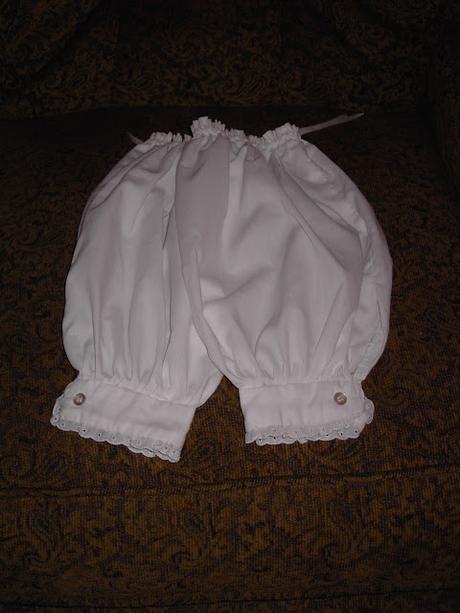
"Undersleeves" in cotone bianco da vestire sotto le ampie "Pagoda Sleeves" utilizzate in alcuni corpetti al tempo della Guerra di Secessione. Queste "undersleeves" venivano attaccate sopra il gomito e sono rifinite con pizzo ad occhiello ai polsi.
Fu questo un dettaglio che piacque molto ai disegnatori di moda parigini e ben presto divenne a far parte degli abiti delle gran dame d'Europa e forse fu proprio questa la prima ed unica volta in cui l'America dettò legge, per caso fortuito, tra parentesi, in fatto di moda.
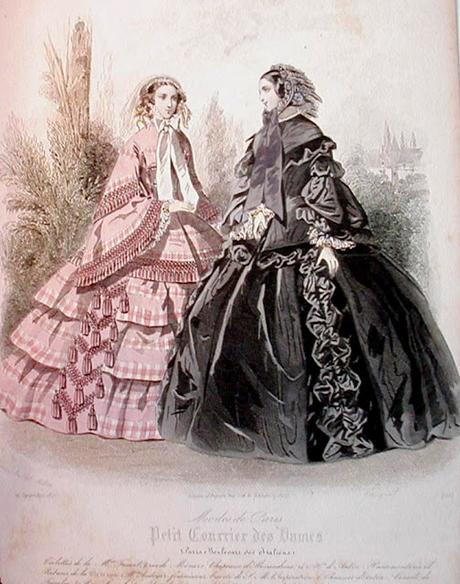
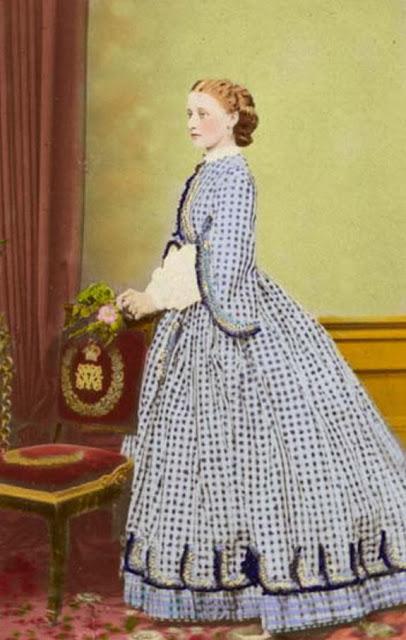
Princess Louise of Great Britain indossa un abito con Pagoda Sleevs e undersleeves che sono chiuse al polso e terminano con il polsino.
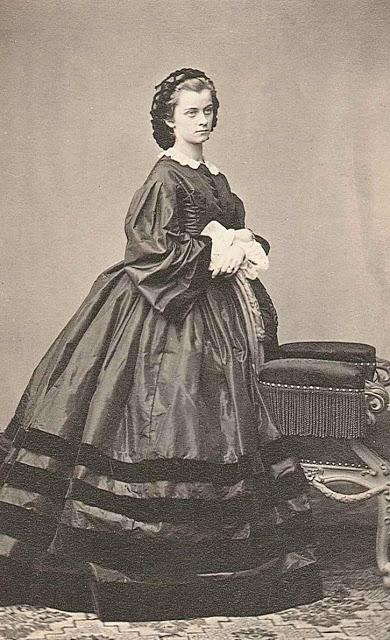
Arciduchessa Sofia Charlotte in Bayern indossa una crinolina a semicupola con Pagoda Sleeves e undersleeves.
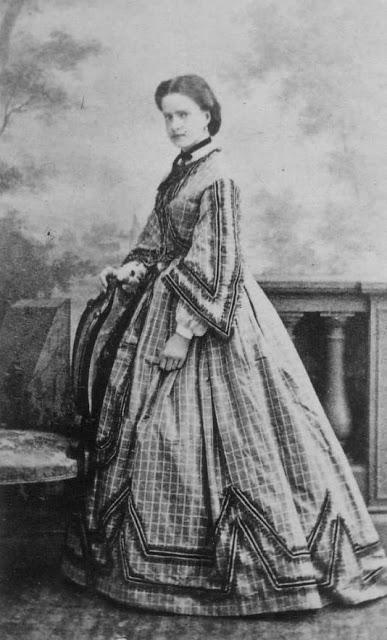
Maria Pia di Savoia, Regina del Portogallo, la quale indossa un abito con Pagoda Sleeves.
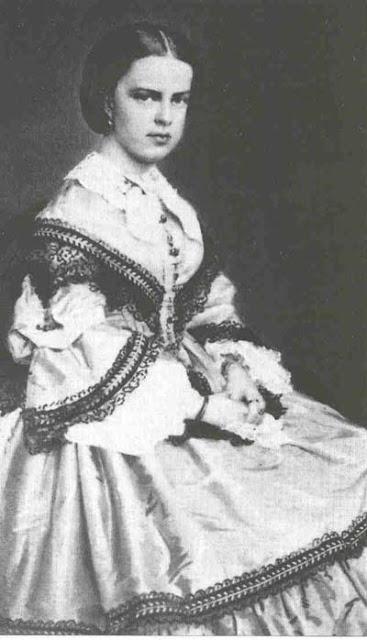
La giovane principessa d'Italia Maria Clotilde di Savoia indossa corte Pagoda Sleeves che terminano con undersleeves.
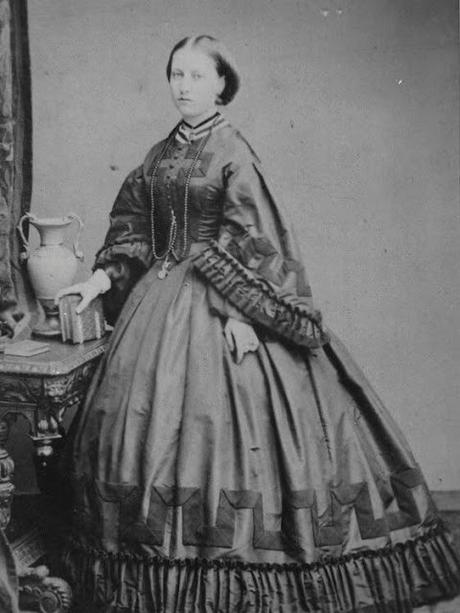
La giovane principessa Helena of Great Britain indossa una crinolina con Pagoda Sleeves
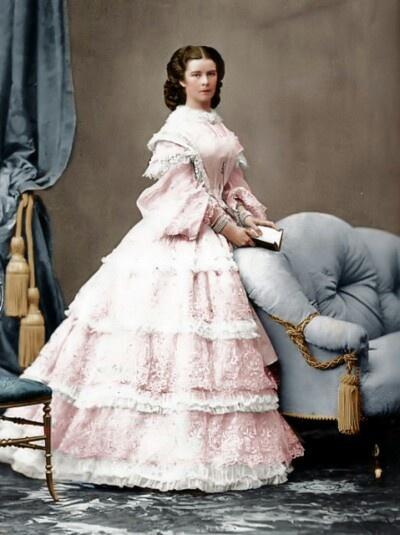
Sisi indossa un abito bianco con Pagoda Sleeves. Foto di Ludwig Angerer, 1860.
Anche oggi il nostro tempo sta per scadere, ma non prendo congedo da voi senza avervi prima doverosamente ringraziati per tutto quanto mi date, vi auguro ogni bene e vi abbraccio con affetto.
A presto ♥
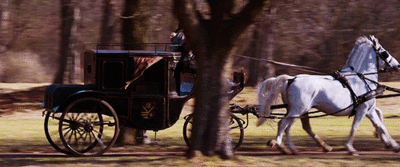

FONTI BIBLIOGRAFICHE:
Stella Blum, Fashions and Costumes from Godey's Lady's Book: Including 8 Plates in Full Color ( Dover Fashion and Costumes ), Dover Publications, 1985;
Mark Campbell, Civil War Ladies: Fashion and Needle-Arts of the Early 1860's, L.R.Shep Publications, 2007;
Juanita Leisch, Who Wore That?: Women's Wear, 1861-1865, Thomas Publications ( PA), 1995.

Fashion is a social agreement, the result of a consensus of a large group of people. Stella Blum (1916 - 1985)
- picture 1
From an economic point of view even before the Civil War, in America, the differences between North and South were considerable: the North, more populous, prosperous, urbanized and industrialized, the South which still held itself to an agricultural economy ruled by ' King Cotton ', so we may say that over that of slavery there was also an economic motivation which led to this disastrous conflict that saw the South become increasingly poor (the Confederate States, investing as much as they could to the war effort, blocked their exports of cotton hoping in the help of the European countries such as France and Great Britain whose textile industries they were the main suppliers, but this hope was disappointed and they found themselves losing their markets overseas, since France and Great Britain chose India and Brazil as new markets, and to live in a sort of autarky: the price not only of a luxury item, but also of a manufacturing was prohibitive.
In 1864, when the monthly pay of a soldier was 18 $ a toothbrush costed $ 8 and to buy a pocket boxcutter or a pound of coffee it was necessary a full salary, $ 18. ( Needless to say that the economy at the end of the conflict was compromised and was back in vogue a kind of barter.) The States of North demographically grew visibly because the migration from Europe made their way to the them, and their economy, as a result, found a great beneficial, although, of course, it was the military one the privileged economic sector.
Making a general 'speech', the women who had remained at home with their elderlies, their children and men in poor health that the army had refused, had to do their best to procure everything, from the most mundane to the most necessary and indispensable thing, as much in the South as in the North.
And of course the clothing, although part of the basic necessities, came after the supply of foodstuffs, which in the South continued to be given largely from the ground, in the North had to be compulsorily purchased.
- picture 2
Do you have in mind those sweet dresses with patterns with small flowers, small squares, pois, that make you fall in love?
Well, during the Civil War it was almost impossible to find fabric and the few that were on the market had prices completely inaccessible, so women rushed out using what they had at home: towels, sheets, scraps of fabric to be put together with the help of imagination and creativity, playing with the aid of inserts and details, sometimes very elaborate ...
- picture 3
- picture 4
- picture 5
And then make their appearance and become 'fashionable' clothing with bright colors, vivid stripes and squared motifs, the so-called PLAID DRESSES by a unique sweetness that make of this a unique period in the history of fashion since every woman seemed to become a doll with such gowns,
- picture 6
- picture 7
- picture 8
even if this is justified by the economy of the sad historical period we are talking about.
Surely you all remember the scene in the movie Gone with the Wind in which Scarlett O'Hara, quite restless, snatches from their stick, the bright green velvet curtains adorning the large living room window of the magnificent mansion of the estate of Tara, asking Mamy for sewing her a suit to 'pay a visit' her Rhett:
- picture 9
curtains, yes, the massive marquees which were the detail that made it more attractive the salons of wealthy families' residences, of landowners in the South or of the inhabitants of the first urban centers in the North were no longer needed, the shutters were often kept closed so as to give the impression that the house had been abandoned (if you think there was no man in the house that could handle any weapons to defend the family and women were trying to defend themselves as they could ) and even these meters of fine cloth, together with the trimmings which adorned them, were used for making clothes, obviously those more sophisticated, for walking or ceremonies.
- picture 10
- picture 11
- picture 12
The wideness of the cuts of this kind of fabrics was what it was and sometimes they were not long or heavy enough, therefore, to overcome these limitations we see dresses with overlapping, layered, with large sleeves, without cuffs, which don't cover the entirety of the length of the arm: they become in fact fashionable in this period also the so said PAGODA SLEEVES, large sleeves that end at the height of their wideness, under which they were worn, for not to leave penetrate the cold, under-sleeved made of white fabric, maybe quite abundant to the wrist, often embroidered, sewn up to the shoulder or attached to the corset to be used with different clothes.
- picture 13 -White cotton "undersleeves" for wear under the wide "Pagoda" style sleeves used in some civil war bodices. These undersleeves tie above the elbow and are trimmed with eyelet lace at the cuffs.
This was a detail that really pleased the fashion designers in Paris and soon became part of the clothing of the great ladies of Europe and perhaps it was this the first and only time in which America called the shots, for unforeseeable circumstances, including Incidentally, about fashion.
- picture 14 - A page of the 'Petit Courier des Dames' dated 1860
- picture 15 -Princess Louise of Great Britain wears a dress with Pagoda Sleeves and under-sleeves that are closed at the wrist and probably end with cuffs in this photo.
- picture 16 -Archduchess Sophie Charlotte in Bavaria wears a half-dome crinoline with Pagoda Sleeves and under-sleeves in this photo.
- picture 17 - Maria Pia di Savoia, Queen of Portugal, wearing Pagoda Sleeves.
- picture 18 -The young Princess of Italy Maria Clotilde di Savoia wearing short sleeves that flare out, Pagoda Style, ending in under-sleeves.
- picture 19 -Young Princess Helena of Great Britain wearing a crinoline with Pagoda Sleeves
- picture 20 -Sisi wearing a white gown with Pagoda Sleeves. Photo by Ludwig Angerer, 1860.
Even today, our time is running out, but I do not take leave of you without first having duly thanked all of you for what you give me, I wish you all the best and I embrace you affectionately.
See you soon ♥


Stella Blum, Fashions and Costumes from Godey's Lady's Book: Including 8 Plates in Full Color ( Dover Fashion and Costumes ), Dover Publications, 1985;
Mark Campbell, Civil War Ladies: Fashion and Needle-Arts of the Early 1860's, L.R.Shep Publications, 2007;
Juanita Leisch, Who Wore That?: Women's Wear, 1861-1865, Thomas Publications ( PA), 1995.

